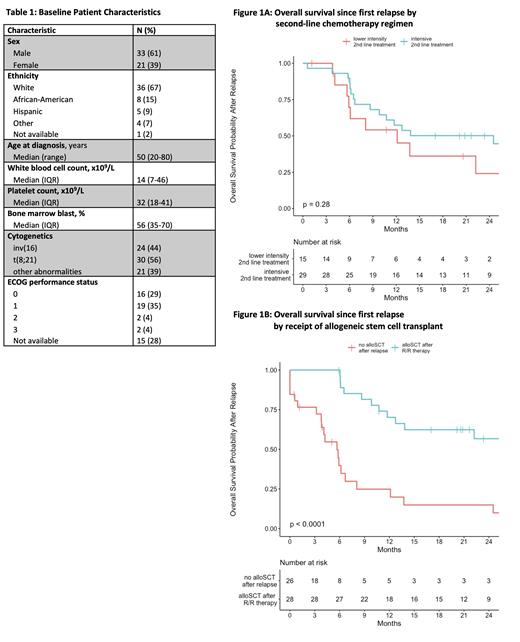Background: Core-binding factor acute myeloid leukemia (CBF-AML) is characterized by the presence of inv(16)/t(16;16) or t(8;21), and is classified as favorable risk by the 2022 European LeukemiaNet (ELN) guidelines. High remission rates are observed in the setting of cytarabine- or anthracycline-based induction regimens. However, for the subset of patients (pts) who relapse, outcomes after relapse were poor in prior single-center analysis with median survival of less than 1.5 years (Khan et al. Clin Leuk Lymph Myeloma 2017). There remains a need to better understand outcomes of pts who experience relapse after initial complete remission (CR), particularly after diverse intensive chemotherapy (IC) induction regimens, where variable practices show differential induction outcomes. We set out to investigate the outcomes of pts with CBF-AML in first relapse or with disease refractory to initial therapy, across 5 institutions that are part of the Consortium on Myeloid Malignancies and Neoplastic Diseases (COMMAND).
Methods: Retrospective chart review was done to identify pts who were treated with intensive IC with inv(16)/t(16;16) or t(8;21) identified on cytogenetics, from January 2010 through April 2023, with disease in first relapse after initial CR or refractory to primary induction. Pts were treated across 5 geographically-diverse, academic institutions. Pt clinical characteristics, cytogenetics, molecular testing via next-generation sequencing (NGS), treatment, relapse, and overall survival (OS) data were collected. OS since time of disease relapse was analyzed using Kaplan-Meier analysis.
Results: Fifty-four consecutive pts with relapsed/refractory (R/R) CBF-AML were identified, 24 (44%) with inv(16) and 30 (56%) with t(8;21). Median age of pts at initial diagnosis was 50 years (yrs) (range 20-80yrs), with 61% male pts. Molecular testing and/or NGS was available at initial diagnosis for 41 pts (76%); 12 (22%) pts had adverse-risk ELN cytogenetics or mutations when excluding CBF status, and 8/41 (20%) pts harbored KIT mutations. Other baseline pt characteristics are listed in Table 1.
All pts underwent induction with IC; 14 (26%) pts received intensive induction with gemtuzumab ogozamicin (GO), 3 (6%) received intensive induction with a KIT inhibitor (dasatinib or midostaurin), and the remaining 37 (68%) received IC induction without a targeted agent. Forty-one (76%) pts achieved a CR to induction therapy. Measurable residual disease (MRD) testing by polymerase chain reaction (PCR) and/or fluorescence in situ hybridization (FISH) for CBF protein was available in 30 (56%) pts, with 16/21 (76%) achieving MRD-negativity by PCR and 20/26 (77%) by FISH. Forty-six pts underwent consolidation with a median of 4 cycles of chemotherapy (IQR 3-4), with 9 (17%) pts receiving GO with consolidation and 4 (7%) receiving a KIT inhibitor with consolidation.
Median time to relapse was 10.1 months (IQR 8.0-13.6 months), and median OS after relapse was 9.2 months (IQR 4.4-22.1 months) for the whole cohort. Second line treatment data was available for 44 pts, with 29 (66%) receiving intensive 2nd line therapy vs 15 (34%) receiving lower intensity 2nd line therapy; 14 (32%) pts received venetoclax as part of their 2nd line therapy. There was no significant difference in 2-yr OS after relapse for those who received IC (50%, 95% CI: 34-72%) vs lower intensity therapy (24%, 95% CI: 8-72%) ( p=0.28) (Figure 1A). Twenty-eight (52%) pts who received 2nd line therapy for R/R disease proceeded to allogeneic stem cell transplantation (alloSCT), with a 2-yr OS of 57% (95%CI: 40-80%) for this group after time of relapse, compared to 15% (95% CI: 5-42%) for those who did not achieve CR after 2ndline therapy and/or proceed to transplant ( p<0.01) (Figure 1B).
Conclusions: In this multi-center retrospective study of pts with R/R CBF-AML, we describe patterns of relapse after intensive induction chemotherapy, and do not observe a statistically difference in outcomes based on intensity of 2nd line therapy among pts with available treatment information. Median OS in the entire cohort was 9.2 months from diagnosis of R/R disease. Pts who proceeded to alloSCT after receiving 2nd line therapy had significantly improved long-term outcomes compared to those who did not proceed to alloSCT, highlighting the need for better therapies in the 2nd line and beyond to improve longer term outcomes for pts with CBF-AML.
Disclosures
Abaza:Rigel: Honoraria, Membership on an entity's Board of Directors or advisory committees; Astellas: Honoraria, Membership on an entity's Board of Directors or advisory committees; Servier: Honoraria, Membership on an entity's Board of Directors or advisory committees; Pfizer: Honoraria, Membership on an entity's Board of Directors or advisory committees; Kite: Honoraria, Membership on an entity's Board of Directors or advisory committees; BMS: Honoraria, Membership on an entity's Board of Directors or advisory committees; Novartis: Research Funding; Biomea: Research Funding; Curis: Research Funding; Biosight: Research Funding; ALX Oncology: Research Funding. Shallis:Gilead Sciences: Consultancy; Curio Science: Consultancy; Bristol Myers Squibb: Consultancy; Servier: Consultancy; Rigel: Consultancy. Kota:Pfizer: Honoraria; Incyte: Research Funding; Novartis: Honoraria; Kite: Honoraria. Patel:Pfizer: Research Funding; Kronos Bio: Research Funding; AbbVie: Honoraria; BMS: Honoraria.


This feature is available to Subscribers Only
Sign In or Create an Account Close Modal